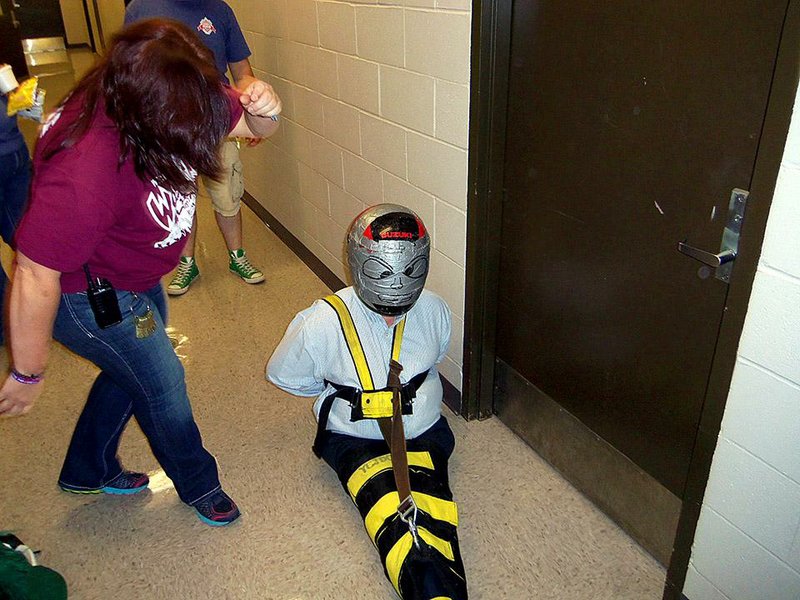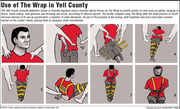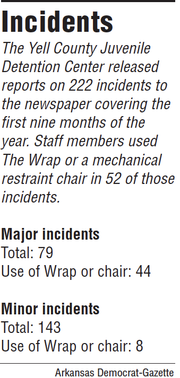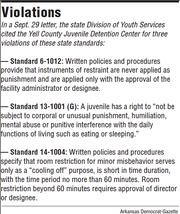One kid threw wet socks. Another flipped off a staff member. Several others beat on doors and walls in their cells and didn't stop when asked.
The Yell County Juvenile Detention Center in Danville used a restraint device known as The Wrap for at least two years to punish incarcerated teenagers for acts such as yelling, banging on doors, name-calling, rude gestures and throwing wet socks. The lockup stopped using The Wrap in September after the state Division of Youth Services learned of the practice. After the agency took the action, the Democrat-Gazette requested incident reports from the juvenile detention center for the first nine months of the year.
At the Yell County Juvenile Detention Center, behavior like this, and not violent altercations with staff members, most often earned youths time in a restraint device known as The Wrap, an Arkansas Democrat-Gazette investigation has found.
The use of The Wrap to punish youths at the detention center became public last month as state officials demanded that it stop. In response, Yell County Sheriff Bill Gilkey had the device removed from the facility and instituted a policy prohibiting its use as well as a mechanical restraint chair.
On Monday, state officials said they were going further, ordering an immediate review of the detention center based on the newspaper's findings about the use of The Wrap in the 24-bed lockup in Danville.
Staff members forced youths into The Wrap -- hands cuffed behind their backs, legs strapped together, and chest immobilized by a harness and a strap connected to their feet. In some cases, guards placed a motorcycle helmet wrapped in duct tape over the youths' heads, putting them in near total darkness.
The youths were often left sitting in the restraint device for two hours -- at times in view of other youths, an experience several youths described to a state official as degrading and humiliating.
Internal incident reports, obtained by the newspaper under the Arkansas Freedom of Information Act, shed light on a facility where staff members were given permission to use restraint devices as punishment and youths became accustomed to "getting wrapped" when they acted out.
The reports show that The Wrap was used in response to a handful of violent outbursts. They also include one instance in which a youth was put in the restraint chair because he had harmed himself and threatened to continue.
But the reports show that The Wrap and a mechanical restraint chair were used most often -- in 40 of 52 incidents -- to punish such behavior as verbal insults, vulgar gestures, name-calling, yelling, screaming or banging on walls or doors.
The newspaper's review of the reports covered January through September, but The Wrap was used for at least two years at the Yell County lockup.
Last month, Yell County sheriff's officials, who oversee the facility, said they didn't know until September that the detention center had used the restraint devices as punishment, a practice that is banned by state juvenile detention standards.
The Youth Services Division, which pays thousands of dollars per month to house youths at the facility, and the state's criminal detention review committees, which have oversight over juvenile detention centers, say they also were unaware.
In interviews, Youth Services Division officials and the review committees' coordinator both acknowledged that they relied largely on the Yell County detention center to police itself.
Had the agency's staff or review committees looked at incident reports, they would have found that the juvenile detention center's staff routinely detailed in writing how The Wrap was used.
"[The youth] threw sopping wet socks and cups of water on people that were out at rec[reation]. He was placed in the WRAP," one staff member wrote in a report.
In another report, a staff member noted that a youth "was calling staff names and was warned that he would be placed in the WRAP if he continued.
"He told staff that [they] were were not going to put him in the WRAP. He went into it very calmly," the staff member noted.
Over the first nine months of this year, the reports show that on average, The Wrap and a mechanical restraint chair were used a little more than once a week. The reports were written by multiple staff members, and most indicate that authorization to use restraints came from supervisors or the facility's administrator.
Minor offenses
The incident reports offer a rare window into daily life inside the Yell County Juvenile Detention Center, which like similar facilities, operates largely outside the public eye, behind the veil of juvenile confidentiality laws.
A daily onslaught of disobedience, insults and rudeness confronts the center's staff. Fights between youths are common, requiring the juvenile officers to put themselves at risk while breaking them up. And juvenile officers reported being punched, scratched and kicked by youths, some the size of large adults.
But staff members also related using restraints for minor misbehavior.
"During routine med pass [the youth] 'flipped me off.' He had been disruptive all evening. [The youth] was placed in the WRAP," a staff member wrote.
"Once in restraints, staff was informed that another juvenile had threatened [the youth], telling him that if he didn't do something to get put into the WRAP that he would take his food from him and 'stomp his head in,'" the staff member wrote.
The report doesn't indicate how long the teen was in the restraint before he divulged that he had misbehaved under duress.
The incident was one of three in which youths at the facility apparently manipulated staff into using The Wrap. On at least two occasions, teens acted out solely so they could be placed in the device. Staff members obliged.
On another occasion, a youth threatened to continue beating on his door until he was placed in The Wrap. In that case, staff members placed him in the restraint chair instead.
Staff members also reported using The Wrap, a mechanical restraint chair or, in one case, pepper spray in response to "minor incidents."
One youth had a seizure while in The Wrap and had to be taken to a hospital.
Staff noted on the report that the child had refused to take his seizure medication for a week prior to the incident. It's unclear from the report whether staff members knew he was off his medication before they placed him in the restraint.
The incident reports vary in the details provided. The reports include a place for staff to list injuries they suffered, but provide no blank to list injuries to the youths. Few injuries or medical problems were noted with the exception of the seizure.
The youths' names and other identifying information were redacted from the reports per state juvenile confidentiality laws. Because of the redaction of the reports, it's impossible to determine how many times the same youths were placed in The Wrap. Some reports mention previous restraints, and some don't.
The reports also don't indicate when the device was used in conjunction with the motorcycle helmet that put the youths in near total darkness while restrained. Staff members usually just wrote "proceeded to The Wrap" or similar language.
In response to questions earlier this month, Capt. John Foster, the chief deputy of the Yell County sheriff's office, said that the sheriff knew the juvenile detention center was using The Wrap, but didn't know it was being used in conjunction with the tape-wrapped motorcycle helmet.
The sheriff's office also believed The Wrap restraint system was being used according to policy as a safe way to restrain violent subjects without the risk of positional asphyxia -- a condition that occurs when a person can't breathe because of the position or posture of his body.
In response to attempts last week to discuss the use of The Wrap detailed in the incident reports, Foster replied by email.
"We don't have any further comment right now on that other than the use of that equipment had ceased prior to the publication of any news articles on the subject, the director of the facility at the time is no longer employed by our agency, and we are working with DYS to move forward with additional training for our staff," Foster wrote.
Foster did not respond to additional written questions submitted by the Democrat-Gazette.
Telephone messages left over three days' time for the facility's new director, Robin Barefield, weren't returned. Barefield, who became director last month, was previously assistant director of the juvenile detention center. She was also among the supervisors who authorized use of The Wrap, according to the incident reports.
A message left with the husband of former facility director Kristi Padgett, who resigned last month, wasn't returned by Monday evening.
'Clearly for punishment'
Scott Tanner, the state's only juvenile justice ombudsman, said the reports show that the facility had a cultural problem of using restraints in a manner that went against the "goals of the state's juvenile justice system."
After reviewing the reports obtained by the newspaper, Tanner was particularly critical of incidents in which staff noted that youths were calm when they went into the restraint.
"That's clearly for punishment. That's not preventing someone from injury to self or others," Tanner said.
Tanner discovered the device's use in early September and reported it to the Youth Services Division. He was also placed in the restraint and the tape-covered helmet by staff members as a demonstration of their typical procedure.
C. Edward Hammond, president and CEO of California-based Safe Restraints, which manufactures The Wrap, said he couldn't comment specifically on how Yell County was using his product, but when used properly, the device has a "great safety record."
The company supports using verbal de-escalation and other calming techniques before resorting to The Wrap, particularly when handling juveniles, he said.
"The Wrap is in place where you're in a last-resort situation, violence is occurring and there's a physical danger to staff and the subjects," Hammond said.
Human Services Deputy Director Keesa Smith, who was recently appointed interim director of the Youth Services Division, said the agency allows use of The Wrap only in the "worst-case scenarios."
The Yell County facility is one of five county-operated juvenile detention centers that the state uses to house youths while they're awaiting space in state treatment centers or on short timeouts from their state program due to misbehavior.
The Youth Services Division has housed hundreds of youths in Yell County over the past few years, often taking up a large share of the beds at the juvenile detention center, according to payment invoices.
Smith said the reports obtained by the newspaper back up the agency's cease-and-desist letter sent to Yell County on Sept. 29. She also noted problems with several incidents, including one in which a child had "given a staff member the middle finger."
"I don't know if this is specifically a DYS child, but any child that's in the system shouldn't be placed in The Wrap system for something as minor as that," she said.
Immediate review
After Smith reviewed the reports, the division began looking into the incidents to identify any youths in state custody who were placed in The Wrap.
Amy Webb, a spokesman for the division, said that also in response to the newspaper's findings, Human Services Director John Selig ordered a facility-wide review of the Yell County lockup that will likely occur today.
Selig's order came after Youth Services Division officials found that the Yell County lockup hadn't been providing the agency with incident reports as required, and when asked for reports, documents provided by the lockup raised questions, Webb said.
"We requested from Yell County the incident reports related to The Wrap system, and we got different information than you did. We got some reports that were the same as yours, then some that you didn't have and then we did not get some that you had," Webb said in an interview. "It was clear we did not have a full picture of what had happened and was happening at the facility."
Webb said the review will be conducted by the Youth Services Division's investigator and encompass all aspects of the facility.
"If we find something egregious and need to take action, we will do that. What we've seen so far is Yell County is willing to address issues and work with us," Webb said.
Looking back, Webb said the agency didn't have enough staff to independently review each facility, and it will always have to rely to some extent on self-reporting at facilities it contracts with.
"Obviously, it's a manpower issue. We can't be at all the facilities all the time," Webb said.
Webb said the division hopes that the hiring of four staff members will help it regularly monitor facilities such as the Yell County center to make sure they adhere to the expectations of the division and the Arkansas Juvenile Detention Standards.
But the division only has authority over youths in its custody.
The state Criminal Detention Facilities Review committees in each judicial district are charged with inspecting the county-run juvenile detention facilities.
The Yell County juvenile detention center passed each annual inspection conducted by the committee in the 15th Judicial District in 2011, 2012 and 2013, according to copies obtained under the Freedom of Information Act.
Danny Hickman, the coordinator of the committees, said that the center wasn't cited for any problems with restraints because the standards only require that the review committees make sure that the facilities have written policies that ban using restraints as punishment.
The Yell County center had such policies in those years, according to the inspection reports.
When used properly, Hickman said, restraints are a good tool to subdue out-of-control youths, some of whom can be larger than most adults. But he said, "they're not supposed to be used for punishment."
"As far as me making sure they follow policy, I can't. I'm a kind of one-man band, and I have 122 facilities to look at each year," Hickman said.
"Since this came up, we'll definitely be looking at that a little closer," he added.
A Section on 11/18/2014



